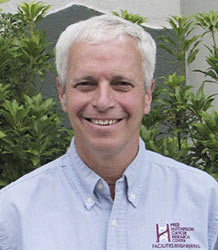Managers Roundtable: Utility Incentives Help Reduce Energy Coststest
By Dave Lubach, Associate Editor
November 2016
Taking advantage of utility rebates seems like a no-brainer for maintenance and engineering managers looking to reduce energy use and costs in institutional and commercial facilities. But managers must do their homework. In this online roundtable, we discuss strategies and utility incentive experiences with the following managers:
 Craig Petersen, Director of Operations, Facilities Management, University of San Francisco
Craig Petersen, Director of Operations, Facilities Management, University of San Francisco
 Phil Hacker, Supervisor of Buildings and Grounds, Kettering (Ohio) City School District
Phil Hacker, Supervisor of Buildings and Grounds, Kettering (Ohio) City School District
 Bob Cowan, Director of Facilities Engineering, Fred Hutchinson Cancer Research Center, Seattle
Bob Cowan, Director of Facilities Engineering, Fred Hutchinson Cancer Research Center, Seattle
Question: Describe the process you use to evaluate rebate and incentive programs.
PETERSEN: The first step for us is to make sure the rebates or other incentives are aligned with our sustainability and maintenance goals. I think there’s a risk that you can get caught up in chasing incentives that aren’t necessarily important. So it would be kind of like impulse buying when you wander through a supermarket and maybe start picking up things you really don’t need just because they’re on sale. I really don’t think that’s healthy at the household level or our level. After that, we look at the payback period, compatibility, terms and conditions of the rebate, and a variety of other factors.
COWAN: We don’t evaluate the rebate and incentive program. We evaluate the projects we are trying to do and then see if they fit into an existing rebate or incentive program. In evaluating a project, we of course look at the payback period, but we look much deeper than that. Can this project bring other benefits to the table? Are we replacing an aging piece of gear that we would have to replace anyway? Can we improve our reliability (and) decrease our maintenance, and can we do the project without putting our facilities at risk? For instance, if I want to upgrade an air-handler, can I afford to shut it down for a week? Many good projects die on the vine because the negative impact of doing them is too great.
HACKER: We conduct a full-fledged energy audit, and we generally solicit our utility. They have graciously funded a good portion of those energy audits. And what we do is go through literally every room of every building in the school district, which is more than 1.5 million square feet, and just evaluate the lighting, HVAC system, cooling and heating, ventilating, anything that makes sense to consider an upgrade to, whether it’s chillers, boilers, and motors of any types. We get all that on paper and ask for various recommendations for what they have incentives for. We group them by building, and we rank them depending on return on investment and how quickly the cost of making the improvements compares with the payback, including the incentives. After we’ve weighted that, we (look at) improvements that will net us 25 percent or more for return on investment, and we target those investments.
How frequently does your facility use incentive and rebate programs?
COWAN: We are a big user of the rebate programs. Since 1999, we have done more than 180 different rebates and incentives, or about 10 per year.
PETERSEN: We use the programs several times a year. Currently, we’ve got about three or four projects that are ongoing. Some of our recently approved projects include an LED retrofit, installing variable-speed motors in several different applications, and upgrading our pool filtration system to reduce our water consumption.
HACKER: About every other year we do a pretty significant project. Whenever it makes sense, we try to do it. We try to get those incentives. Sometimes it’s as simple as we have a variable-frequency drive that goes bad. Oftentimes our utility will offer a standing rebate to replace a variable frequency drive. So as soon as we purchase that, we’ll send them a copy of the invoice and get a portion of that money back.
What perspective do you bring to the team in your role as a maintenance and engineering manager?
COWAN: The perspective I try to bring to table in my role is, “Let’s keep the impact to the facility to a minimum, or at least a tolerable level. Let’s not put in something that is too complicated or difficult to maintain. Let’s replace aging gear and get the rebate money to help fund it, and let’s make our maintenance easier.”
HACKER: I was a former project manager for a general contractor that specialized in institutional construction, so when I came to Kettering schools, up to that point they had promoted from within and really didn’t have someone in the position that brought that sort of a perspective of managing a construction company. When I came into the position here, I initiated a fair amount of accountability to scheduling and adhering to budgets.
PETERSEN: I’ve got a pretty good ability to understand that there are several stakeholders involved in any project, so I’ve encouraged not only our sustainability and our chief engineer to participate in the evaluation process for different projects. I’ve also invited the engineer responsible for the specific building to be actively engaged in projects that we’re contemplating. Of course the end user needs to be satisfied, but I also need to be sure the chosen course of action doesn’t increase the burden on my engineers who are tasked with maintaining the equipment. Of course, this all must get done with a fiscal responsibility, as well as with an awareness of sustainability goals.
What are the most important factors you consider when entering an incentive and rebate agreement?
COWAN: If we qualify, we generally will take the rebate money. Why not? Usually, there are very few strings attached. We don’t evaluate the rebate program. We evaluate the projects. One of the key evaluations is, “Can we do this?” We don’t want to put our institution at risk or our jobs on the line doing a project that looks good on paper (when) the reality is you have to shut down a wing or an air handler for a week to do it.
HACKER: The return on investment and the impact on the staff and the students. Those are our two primary criteria. Payback is always taken into account. There also are some things you have to be cognizant of. When we did our last lighting retrofit, the cost of using LEDs for interior lighting, though the payback was there, technology seemed to be driving those costs down. So we consciously waited to do that retrofit until the cost of LED bulbs dropped, and sure enough, they’ve gone down between 40 and 60 percent. So we’re going to go back and take advantage of those additional savings. Delaying that improvement by a year or two has made a big difference.
PETERSEN: The terms of the agreement are obviously critical. I’ve had several occasions where I’ve sat down with a sustainability coordinator and chief engineer to crunch the numbers and figure out payback times. In some cases we all agreed that making an investment, even with those incentives and rebates, was not the best option, especially if we were going to have to make major upgrades later on. We aren’t shopping for rebates and trying to find a project that fits. We’re trying to identify projects and then finding which rebates and incentives might apply.
What types of incentive-related projects have you found most beneficial?
PETERSON: Any project that helps save water, not only for our concern about the drought conditions in California but the cost of water. I have to purchase the water (and) pay to heat the water for domestic use, and there’s a significant cost associated with the disposing of waste water. Anytime I can reduce water use, I kind of get a three-fold savings on the back end.
COWAN: For us, the best projects are the ones that deal with HVAC. The total spent on air is many times that of lights or plug loads. From air handlers to chillers to boilers, there is a lot of money to be saved. Not that you can’t make money on lights. You can, but the big bucks are in air.
HACKER: The high-bay lights in the gymnasiums, moving toward a fluorescent or LED solution. For exterior lights, we’ve gone to LED on all of our exterior lights already. With HVAC controls corrections, we’ve had equipment running when it shouldn’t have been running. Lighting, and getting (the HVAC system) under control have been the biggest paybacks for us.
What are potential drawbacks involved with rebate programs?
COWAN: One drawback is you have to understand the game. For some rebates, it’s totally free money, and some come with strings attached. For instance, our gas provider has a great rebate program. It’s funded by the small print in our gas bill. For example, all customers pay a slight surcharge to the rebate program, so you want to take more money than you put into the pot. But gas is a competitive market, so if we were to leave our gas provider and go to a competitor, we would have to refund the money we took from the energy provider.
HACKER: There can be strings being attached and dates of expiration. You have to pay close attention to that. If you submit for a project or program, get approved and pre-qualified. But also have the utility honor the completion of the project. And program rules sometimes change. Recently with the dropping of LED prices, utilities have dropped the amount they’re paying for rebates. Getting in writing up front that they’re going honor that through the whole course of the project has been very important for us.
PETERSEN: If you do an online search, there’s all sorts of information warning that you have to be careful with vendor or product selection so you aren’t being taken advantage of. For us, one of the issues is rebate plans requiring establishing baseline usage. Some of those baselines only necessitate a few days of monitoring or a full billing period, but others are far more lengthy.